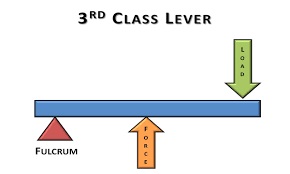- A lever is a simple machine used to life heavy objects.
- Any lever has three parts:
load, effort and
fulcrum/pivot/turning point
- All levers are classified as either: First class, second class or third class levers. This is determined by the arranged of the Load(L), Effort(E) and Fulcrum(F).
First Class Levers
- Fulcrum is between the load and the effort e.g claw, hammer, pliers, see-saw

Second Class Levers
- Load is between the fulcrum and the effort e.g wheelbarrow, nut cracker.

Third Class Levers
- Effort is between the fulcrum and the effort e.g Fishing rod, human hand, spade.

Inclined Planes
- An inclined plane is a slope
- It makes work easier by increasing the effort distance - The greater the effort distance, the lesser the effort.
- Examples of inclined planes are: Ladders, Staircase, Wedge, Screw, road winding up a hill, Ramp

- The picture above shows a staircase. This is an example of an inclined plane.
- The picture below shows another example of an inclined plane - a road winding up a hill.
 The road above is found in South Central China, in the Zhangjiajie National Forest Park
The road above is found in South Central China, in the Zhangjiajie National Forest Park
Single Fixed Pulley
- A pulley is characterized by a wheel with a rope.

- A pulley makes work easier by changing the direction of the force.The effort is applied towards gravity which is much easier.
- A flag is an example of a single fixed pulley.
Characteristics of a Pulley
- Effort is applied towards gravity
- Effort applied is equal to the load
- Effort distance is equal to the load distance
- The pulley has no mechanical advantage















